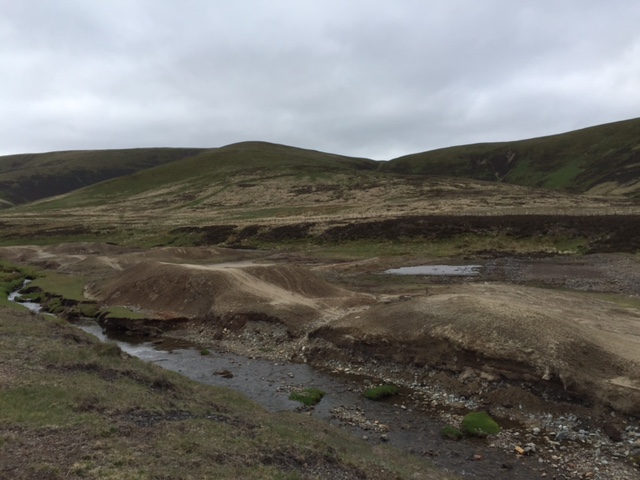The Duke of Buccleuch has come under fire for failing to protect residents and ramblers from toxic waste ponds left over from lead mining in the Dumfries and Galloway hills.
Local people are furious that no action has been taken on a recommendation in an official report two years ago that a fence should be put up to prevent the public from being harmed by hazardous levels of lead and zinc in the Queensberry tailing ponds near Wanlockhead, the highest village in Scotland.
They accuse Buccleuch, the UK’s largest private landowner who owns much of the area, of “environmental carelessness”. The contaminated ponds are skirted by a long-distance footpath used by hundreds of walkers every year.
Pollution of Wanlock Water from old lead workings operated by Buccleuch and others in the past has been investigated by the UK government’s Coal Authority for the Scottish Environment Protection Agency (Sepa).
A report completed in 2014 found high levels of toxic heavy metals such as lead, zinc and cadmium in the river in breach of environmental quality standards. Much of the pollution came from the Queensberry tailing ponds, which contain wastes from centuries of metal mining.
The report recommended a series of measures to clean up the ponds, which are followed along their southern edges by the Southern Upland Way, an official walking route from coast to coast across Scotland.
It said: “Because of the high percentages of lead and zinc detected in the Queensberry tailings pond sediment, it is recommended that the area should be fenced off to prevent livestock and deter members of the public from entering the site.”
The report also urged further studies into the dangers of contaminated dust being blown into the air in dry weather and inhaled by walkers or residents. The impact of wildlife also needed to be investigated, it said.
But so far no action has been taken to protect the public. “It is deeply disconcerting that, almost two years after this report was published, neither Buccleuch estate nor the local authority have undertaken the necessary steps to ensure that the Queensberry tailing ponds are fenced off,” said Karin Oostindjer, a local resident and keen hillwalker.
“As the landowner, Buccleuch should have, at the very least, a moral duty to erect the fencing as a means to protect members of the public, their dogs and any livestock, from the heavy metal pollution.”
Androulla Richford, who lives in Wanlockhead, was also concerned for the safety of children and livestock. “I would say it is negligence and a sign of poor land stewardship as well as environmental carelessness,” she said.
“A fence would at least give unsuspecting people as well as livestock a chance not to wander on polluted land or water.”
The Scottish Labour MSP for the South of Scotland, Claudia Beamish, has written to Buccleuch asking for a fence to be erected. “I am disappointed that access to Queensberry tailings ponds has not been restricted by a fence despite this recommendation,” she said.
“It has long been known there are increased levels of contamination in the ponds and as we move into the summer months, with increased visitors and locals using the area it seems an essential time to do it.”
Dave Morris, a veteran countryside campaigner and former director of Ramblers Scotland, said: “The appropriate authorities need to identify who is responsible for erecting this fencing and ensure that it is put in place as soon as possible, along with signage to warn of the pollution danger.”
Sepa confirmed that Buccleuch was the landowner, and suggested that it would be his responsibility to erect a fence, along with the local authority. “Sepa will continue to work with Dumfries and Galloway Council and other relevant partner organisations to improve any water contamination issues in the area,” said a Sepa spokesman.
Dumfries and Galloway Council said it was investigating the matter. “While the council is responsible for maintaining the Southern Upland Way, it is not the landowner,” a council spokesman said.
Buccleuch pointed out that dealing with the legacy from old mine workings in the area involved Sepa, local authorities, health bodies and local landowners. “A multi-agency public health risk assessment said the risk to human health was low,” said a spokesman for the estate.
“The UK Coal Authority report recommendations did not state that Buccleuch should be responsible for fencing off the area in question and no regulatory or enforcement order has been issued. However, Buccleuch takes its environmental responsibilities seriously and is pursuing the pond sediment fencing issue through dialogue with Dumfries and Galloway Council.”
The report in full
A version of this article was published in the Sunday Herald on 5 June 2016.
Photo of Wanlock Water thanks to Karin Oostindjer.















We should.nationalise his land!
If he cared he’d already have exercised his vast wealth to put fencing up. As usual he’d rather someone else pay for it. No class whatsoever.
The local council should hold their heads in shame, it is they, who should issue an order to erect the fence, appropriate signage and work with the owner to decontaminate the land. If not done then they should start EHS court case against the owner.
If so IMO they should compulsorily purchase the land for buttons (as they would do to, we the people, if they so desired)
There are miles and miles of expensive fencing put up on his grousemoor on Langholm Moor in last few years – to dismay of locals, who told me the cost of fencing was over a million pounds. Paid for, the sign tells you, with EEC and Scot gov grant support. Locals said virtually no work to estate done unless paid for by public grant of some sort or another. Land where you can allegedly travel miles seeing no bird life or wildlife whatsoever unlike adjoining land in different ownership.